Omega Railmaster: A Review of Omega’s Most Underrated Watch

If you’re into vintage watches, you’ve most likely heard about the Omega Railmaster. It is the less popular sibling of the renowned Seamaster and Speedmaster.
Although seldom in the limelight, the Railmaster has an intriguing story that more people should hear. From serving engineers to accompanying pilots, this timekeeper has proven to be fantastic. Read on to find out this anti-magnetic watch’s electrifying history.
Omega Railmaster History

The Three Masters
In 1957, Omega released a triplet of tool watches to fill the need of the market. These were the CK 2913, CK 2914, and CK 2915, or more commonly known as the Seamaster 300, the Railmaster, and the Speedmaster, respectively. These three watches make up the Master Trilogy Collection. And each watch has its own specialty.
The Seamaster’s special ability was its water-resistance. Indeed, it was a gift to professional divers or marine biologists who need to explore the ocean. On the other hand, the Speedmaster is a mathematical genius that can measure short periods of time like a stopwatch. Racecar drivers and astronauts benefited from this function.
Obviously, these two were the more popular models. Who hadn’t, as a kid, dreamed of exploring hidden empires underwater? Or getting a good view of the Earth from the moon? These exhilarating associations with both watches were a big part of their demand. But that’s not to say that their other sibling, the Railmaster, is a lesser watch. In fact, it’s just as good as the other two if people would just pay close attention.
The Unsung Hero
While owners of the Seamaster and the Speedmaster bask in the spotlight, people who wear the Omega Railmaster scrunch up their faces over their microscopes in their labs. They’re busy building tools that are needed for divers to survive the intense pressure and the engines that give racecar drivers their speed.
As can be seen, the Omega Railmaster caters to scientists, engineers, and researchers — basically anyone who works closely with magnetic fields or electric currents. But how does a watch from the late ’50s survive such elements?
Stay Away from Magnets
Before anti-magnetic watches were a thing, magnet was one of the leading causes of inaccuracy in watches. Put your timepiece close enough and these magnetic fields could damage the important parts like the hairspring and escapement. It can even ruin the oscillating frequency of your watch, causing it to tick faster or slower.
The Faraday Cage
As early as 1952, Omega had been researching on how to produce anti-magnetic watches. They did it by using a Faraday Cage, which was named after the scientist who pioneered the study of electromagnetism. Simply put, this piece of technology is a container that’s made of conductive material to prevent electromagnetic fields from ruining its contents. Up to now, watchmakers still use this invention to protect their watches from magnets.

The Omega Railmaster CK2914
As mentioned above, the first Omega Railmaster was a success due to the Faraday Cage. In fact, it was the brand’s first watch that was resistant up to 1000 Gauss.
Aside from the Faraday Cage, Omega used a soft iron called NuMetal on the caseback. And instead of the usual 0.4mm thickness of the dial, they bumped it up to 1mm to further increase the magnetic resistance of the watch. In terms of the movement which the case protects, Omega chose the 30T2. Later on, the brand would change its name into calibres 284, 285, and 286.
When it comes to the dial, the original version of the Railmaster looked a lot like the Seamaster 300. It featured white Arabic numerals that created a high contrast against the pitch-black background. But apart from black, Omega also released a few special editions with different colours and different hands. Today, these are extremely hard to find as the Omega Railmaster was not popular during that time.

The Competition
Unfortunately for Omega, they weren’t the first one to produce an anti-magnetic watch. A few years before the Masters Trio were released, Rolex already had its Milgauss Ref. 6541. Meanwhile, IWC was also busy marketing their Ingenieur Ref. 666.
However, this does not mean that the Railmaster was inferior to the other two models. In fact, Omega had started researching prototyping the Railmaster years before the Milgauss and Ingenieur were introduced. As they say, the watchmakers of Omega wanted to go slowly but surely. Indeed, the wait was very well worth it.

TheTimekeeper of North American and Canadian Pacific Railways
In the early 1960s, Omega started making a special version of the watch. In fact, the product was to be used by the North American and Canadian Pacific Railways. The new version shared the antimagnetic abilities of the previous version. However, they had to tweak the design to meet the requirements of the railroad employees.
Instead of black, the dial of the new version was now white. Additionally, black Arabic numerals took the place of the triangular markers of the old one. In some editions of the watch, they added 24-hour time in red just beside the 12-hour markers.
Unfortunately, the world didn’t get to see the Railroad edition in action for so long. This was because Ball, another company that produced railroad watches, sued Omega. The lawsuit was for using the ‘Official Standard’ text on their watches. Omega lost and was forced to cease production of this special edition of the Railmaster.
Due to the limited number of units produced, the Railroad edition of the Railmaster now fetches a huge price. Indeed, it has become a collector’s item, especially for Omega fans.

Air Force Editions
Aside from railroad companies, Omega also produced editions for the Air Force. And it wasn’t for just one branch, but two! Both the Pakistani Air Force and the Peruvian Air Force received their own Railmaster versions.
But wait, weren’t those Seamasters? Nice catch. The watches had “Seamaster” plastered on their dials. However, this was intentional and beneath the case, the watches are truly Railmasters.
As the story goes, there is a negative connection between railroads and the British Raj’s control of India, Bangladesh, and Pakistan. Before, they thought of railroad conductors as servants of the British Empire. And as military men were expected to be prim and proper, they had to avoid anything that had to do with railroads and the connotation that goes with it. Consequently, Omega changed the print to “Seamaster” instead.
Meanwhile, the Omega Railmaster watches of the Peruvian Air Force read “Flightmaster”. What’s interesting is that during that time, the Omega Flightmaster line was yet to be released.
The End, For Now
As the years went by, the Omega Railmaster became more and more unpopular. It seems that a lot of watch collectors back then could not find the appeal in anti-magnetic watches; until finally, Omega stopped its production in 1963.

A Major Comeback
After a few years, the brand decided to revive the Omega Railmaster in 2003. The watch was available in three sizes — 36mm, 39mm, and 42mm. And each of those versions had Co-Axial escapements, as well as cases that looked a lot like the Aqua Terra. However, the return was short-lived and once again, Omega stopped its production in 2012.
In 2017, Omega wanted to celebrate the anniversary of the “Three Masters”. And they just couldn’t leave the old Railmaster behind. Thus, they re-released it along with the Speedmaster and Seamaster.
However, there is one difference — they placed the returning model under the Seamaster collection, making its official name the Omega Seamaster Railmaster. We don’t know the exact reason behind it, but some suggest that it’s for marketing purposes. It makes sense since the Seamaster line is a lot more popular.
The new Omega Seamaster Railmaster has similar traits it shares with the original version. But this time, it is tweaked to pass the fashion standards of today. Apart from that, the new version is also equipped with a better movement. Let’s take a closer look at it below.
A Good Look at the Omega Railmaster
Specs Sheet
Before anything else, let’s look at the important numbers that make the watch.
- Case: Stainless steel
- Dimensions: 40mm
- Movement: Automatic
- Power reserve: 55 hours
- Water resistance: 150m
- Magnetic resistance: 15,000 Gauss
Based on these numbers, the Omega Railmaster is an impressive beast. It checks out every basic thing that you need. Going on vacation? The water-resistance rating is enough for a quick dip in the lake. Hate adjusting the time every now and then? Its power reserve can last you for more than two days. Working as a scientist or engineer? It won’t be fazed by the magnets around you.
But how do these numbers stack up in real life? Let’s find out below through our hands-on review on the watch.
1. The Case
With a diameter of 40mm, the stainless steel case of the Omega Seamaster Railmaster is neither big nor small. Additionally, its thickness measures at over 12mm. These numbers make the watch feel durable and solidly built. But that’s not to say that the watch is heavy. In fact, it feels compact and comfortable on the wrist.
Meanwhile, the finishing of the case is like no other. No matter which angle you look at, you wouldn’t see any brightly polished surface. Each spot has a soft brushed finish with some grains here and there.
2. The Dial
This Railmaster comes in a black dial, although there is also a dark grey version. Upon closer inspection, the dial bears a vertically brushed finish. These lines are more visible when viewed at certain angles or light conditions.
Furthermore, the hour markers are made with yellowish triangles that can be compared to aged radium. Each of these 12 markers is applied with Super-LumiNova to make it readable in low-light conditions.
Moving closer to the centre, the dial bears a crosshair that bears the Arabic numerals 3, 6, 9, and 12 on each end. It is understood that the crosshair is the symbolism of precision.
Both the logo and “Co-Axial Master Chronometer” are printed in white. Meanwhile, the word “Railmaster” is printed in a script and in the same yellow shade as the hour markers.
3. The Caseback
Flipping the watch over, you’ll see that the steel caseback is just as gorgeous as the dial. At the centre is an embossed picture of the seahorse-like creature associated with the collection. The “Railmaster” text and Omega logo are both placed on the top and bottom of the creature, respectively.
Around it is some clues of its features. These are more for telling its functions than improving the aesthetics. Of course, there are the obligatory words that say the watch is anti-magnetic and water-resistant up to 150m.
Apart from those, it also says “Naiad Lock” on the left side. The Naiad Lock is a patent-pending system that ensures the back of the case is always aligned to show the engravings in the correct position. It’s a pretty useful feature if you obsess over the smallest details.

3. The Movement
Beneath the interesting dial is the Master Chronometer Calibre 8806. This time-only movement has a COSC certificate that proves it passes the official chronometer standard. Apart from that, it has another certificate that’s issued by the Swiss Federal Institute of Metrology (METAS). This assures that the Railmaster can survive magnetic fields of up to 15,000 Gauss.
The Calibre 8806 has one of the highest ratings when it comes to accuracy and precision. In fact, it has an accuracy rating of +4 seconds per day.
Moreover, the movement is self-winding with co-axial escapement. It runs at a frequency of 25,200 vph, has a total of 35 jewels, and can power the watch for up to 55 hours when fully wound.
Hiding the movement inside an opaque caseback did not stop Omega from making it visually pleasing. It bears the usual finish like the deep stripes that radiate from the centre. Apart from that, it has a rhodium-plated finish and the texts are printed in dark red.
Is the Omega Railmaster For You?
Investing in a luxury watch is something to think hard about. Indeed, it is important to know if a certain timepiece is right for you; if you need it, and most importantly, if you will feel proud to wear it on your wrist.
To help you decide about your next watch acquisition, we’ll show you the pros and cons of the Omega Railmaster below.
Pros and cons of the Omega Railmaster
Pros:
- Durable – According to Omega, the Railmaster passed eight stringent tests for durability. In fact, they are confident enough in their watches’ robustness that they offer a five-year warranty.
- Versatile – Its conservative black dial can be dressed up in a lot of different ways. From black denim straps to leather, the Omega Railmaster can blend well.
- Superior precision and accuracy – As mentioned above, the movement of the Omega Railmaster has received not one but two certifications. And according to the brand, the watch is twice as precise as any certified chronometer. With an accuracy rating of +4 seconds per day, the Railmaster is a very reliable watch that will serve you well for years.
Cons:
- Not as popular as the other Omega models – Having an unpopular watch can mean that it can take more effort to ask for sources on the Internet in case you want to fix an issue about the watch. However, if you want to look at the brighter side, this can be also seen as exclusivity and uniqueness.
Omega Railmaster Buying Guide
Have you decided that the Omega Railmaster is the one for you? If yes, then here are a few tips before you get your hands on one.
How to Spot a Fake Omega Railmaster
Omega is one of those watch brands that are popular even outside the community. Due to the traction, it is likely that there are a lot of counterfeit versions of their models. To protect yourself, here are a few things you have to consider when buying your Omega Railmaster:
1. The hands should move smoothly.Perhaps the easiest way to check the authenticity of an Omega Railmaster is its hands. If it sweeps in a fluid motion, it’s a good sign. But if it ticks, you should be concerned. The sweeping movement of the hands is a characteristic of automatic Swiss movements.
2. Check for typographical errors.Producers of low-quality fakes do not even bother to correct spelling mistakes. Examine the dial and make sure that “Omega” isn’t spelt “Onega”.
3. Is the lume bright enough?Omega watches are applied with high-quality pigments that glow in the dark. While a fake one can still have glow-in-the-dark properties, the quality is very different.
When testing, charge the lume by putting the watch under a bright light for no less than 15 seconds. After that, turn off the lights. The dial of the watch should be bright enough to still read the time and should last a while.
4. Check the serial number.It’s a good sign if the seller is kind enough to provide a picture of the serial number. You can double-check on the Internet if the number refers to the exact model of the Railmaster. If it does not match, then you’re holding a fake.
5. If in doubt, ask an expert.A surefire way to know the authenticity of the Omega Railmaster in your hand is by asking an expert. And the term expert can mean a trusted watchmaker or someone at the Omega service centre. Unless you personally know the seller or they have over a thousand positive reviews, you shouldn’t overlook this step.
Final Notes
Despite not being a fan favourite, the Omega Railmaster is a very dependable watch. Its demise in the ’60s was because of its unpopularity and not because of incompetence.
Lucky for us, Omega decided to bring it back. Otherwise, we would have missed out on a very important timepiece. And while the Railmaster is happily operating backstage, there is no denying that it is a gem.
If you’re looking for more underrated gems, check out our article about the Seiko Sumo!


